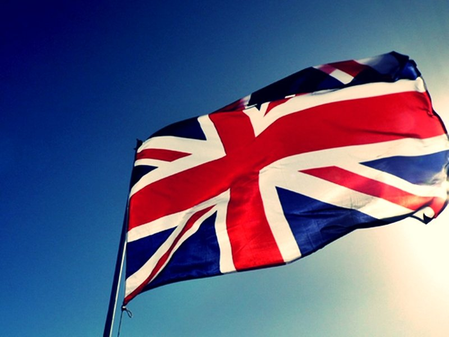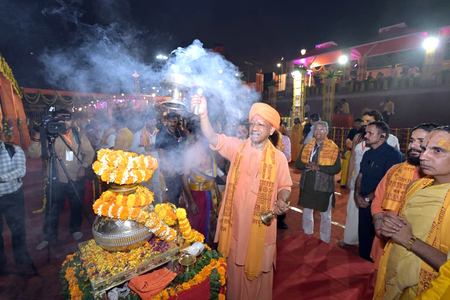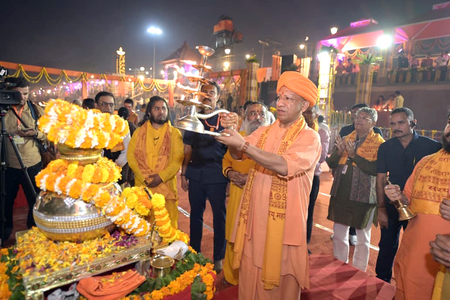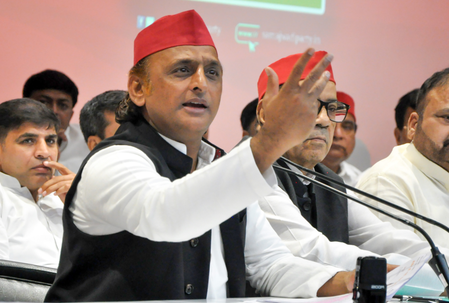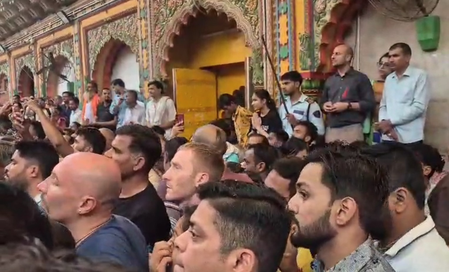
Mathura, Oct 21 (IANS) The holy festival of Govardhan Puja was celebrated with traditional fervour and devotion in the sacred city of Mathura, Uttar Pradesh, on Tuesday. A special puja was organised at the city’s renowned Dwarkadhish Temple, where a large number of devotees gathered from early morning to participate in the rituals.
Govardhan Puja holds special significance in Mathura, the land associated with Lord Krishna’s divine pastimes, as it commemorates the day when He lifted the Govardhan mountain on his little finger to protect the people of Braj from the wrath of Indra, the god of rain. In keeping with tradition, devotees reverently made a replica of the Govardhan mountain using cow dung and worshipped it with rituals performed in the Dwarkadhish Temple complex.
The puja is an important Hindu festival that occurs a day after Diwali. It celebrates the ‘Baal Roop (child form)’ of Lord Krishna and is also known as Annakut or Annakoot, meaning “a mountain of food”. On this day, devotees worship Govardhan Parvat (hill) and offer 56 varieties of vegetarian food and sweets, known as ‘Chappan Bhog’, as an expression of gratitude and devotion.
The festival symbolises the powerful bond of faith, protection, and divine grace between gods and devotees. The story of Govardhan Puja teaches people to respect the forces of nature and to remember that, as mortals, we are deeply dependent on Mother Nature and must remain grateful for her blessings. Lord Krishna’s act of lifting the mountain and saving the villagers demonstrates that bhakti (devotion) is the purest way to connect with divinity.
According to the tale, Lord Krishna lifted and sheltered all the living beings of Gokul under the massive Govardhan mountain. The significance of Govardhan Puja lies in the unshakable belief of devotees in their Lord, trusting that He will protect them in every crisis and against all odds.
As per the Vishnu Puran, once young Krishna asked his mother, Yashoda, why the villagers worshipped Lord Indra. She explained that Indra was the god responsible for bringing rain to Earth. Krishna disagreed and urged the villagers to stop worshipping Indra and instead honour Mount Govardhan, as it provided them with essential resources for their daily life. The villagers agreed with Krishna, who was highly respected for his wisdom and divine power.
Angered by this, Indra ordered Varuna Deva (the god of rain) to unleash a torrential downpour for seven days to punish the villagers. Faced with severe flooding, the people of Gokul turned to Krishna for help. In response, Krishna uprooted the Govardhan mountain and held it aloft on his little finger, providing shelter to all — humans, animals, and birds.
After seven days of continuous storms, Indra realised Krishna’s divine nature and accepted defeat. He acknowledged that the young boy was none other than an incarnation of Lord Vishnu. Since then, Govardhan Puja has been observed as a celebration of nature, humility, and divine protection.
‘Govardhan Parvat’ has now become a major pilgrimage site for devotees of Lord Krishna. On the day of Annakut, thousands of devotees perform the ‘Parikrama’, a sacred 11-mile circumambulation around the mountain, offering flowers, diyas (lamps), and food at the various shrines along the route.
–IANS
jk/dpb

